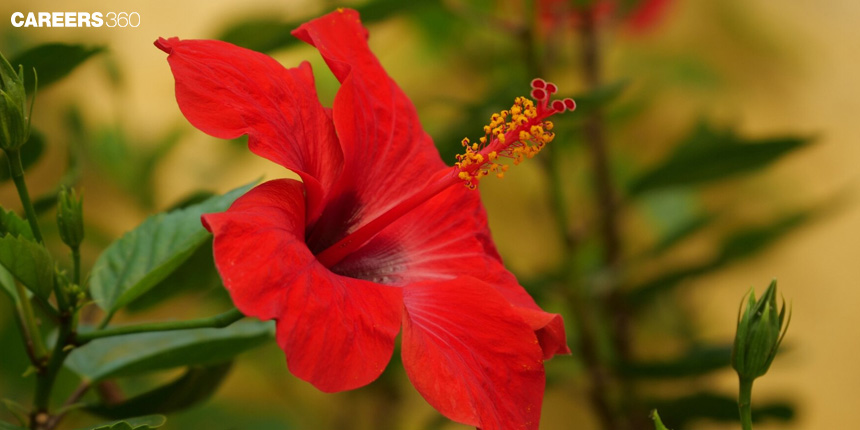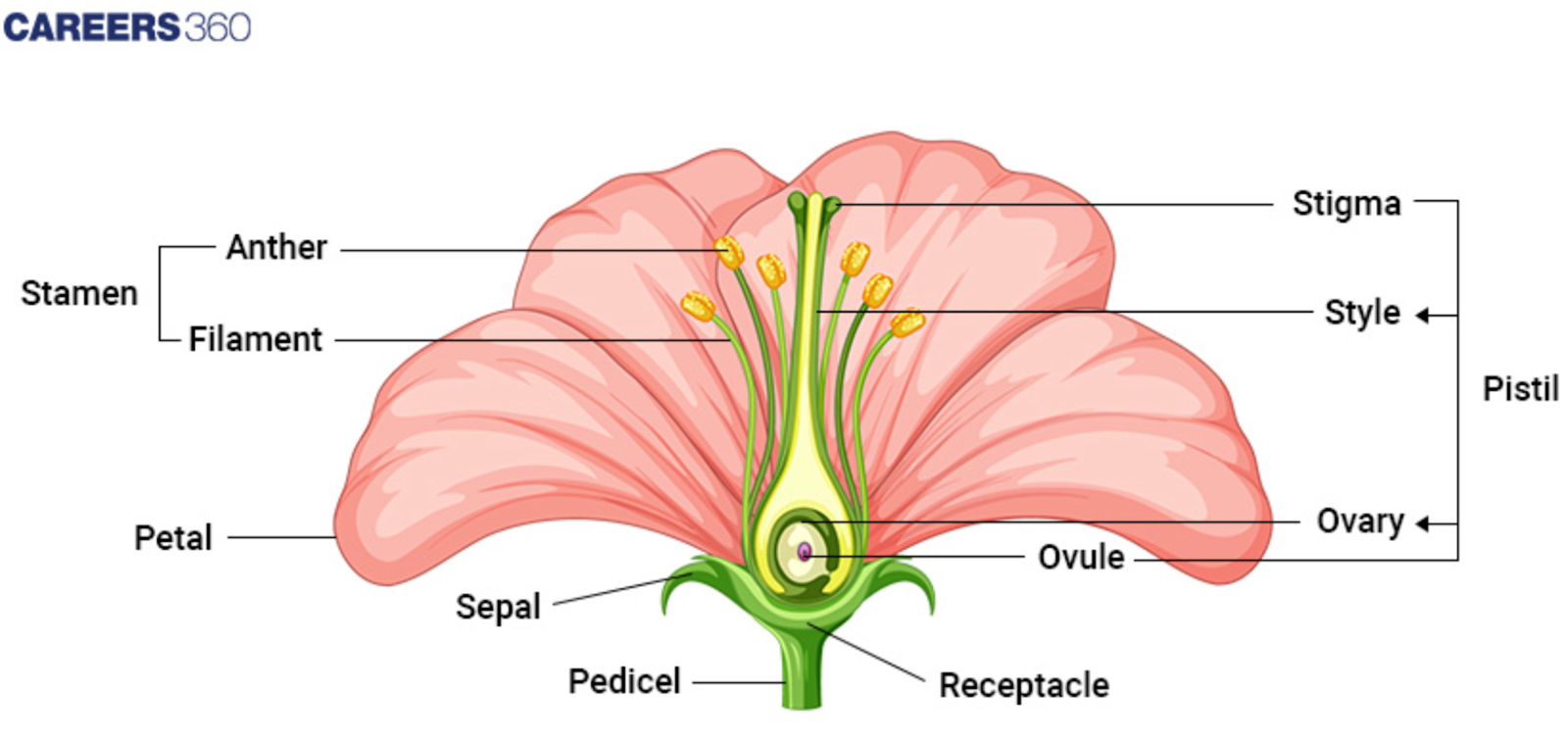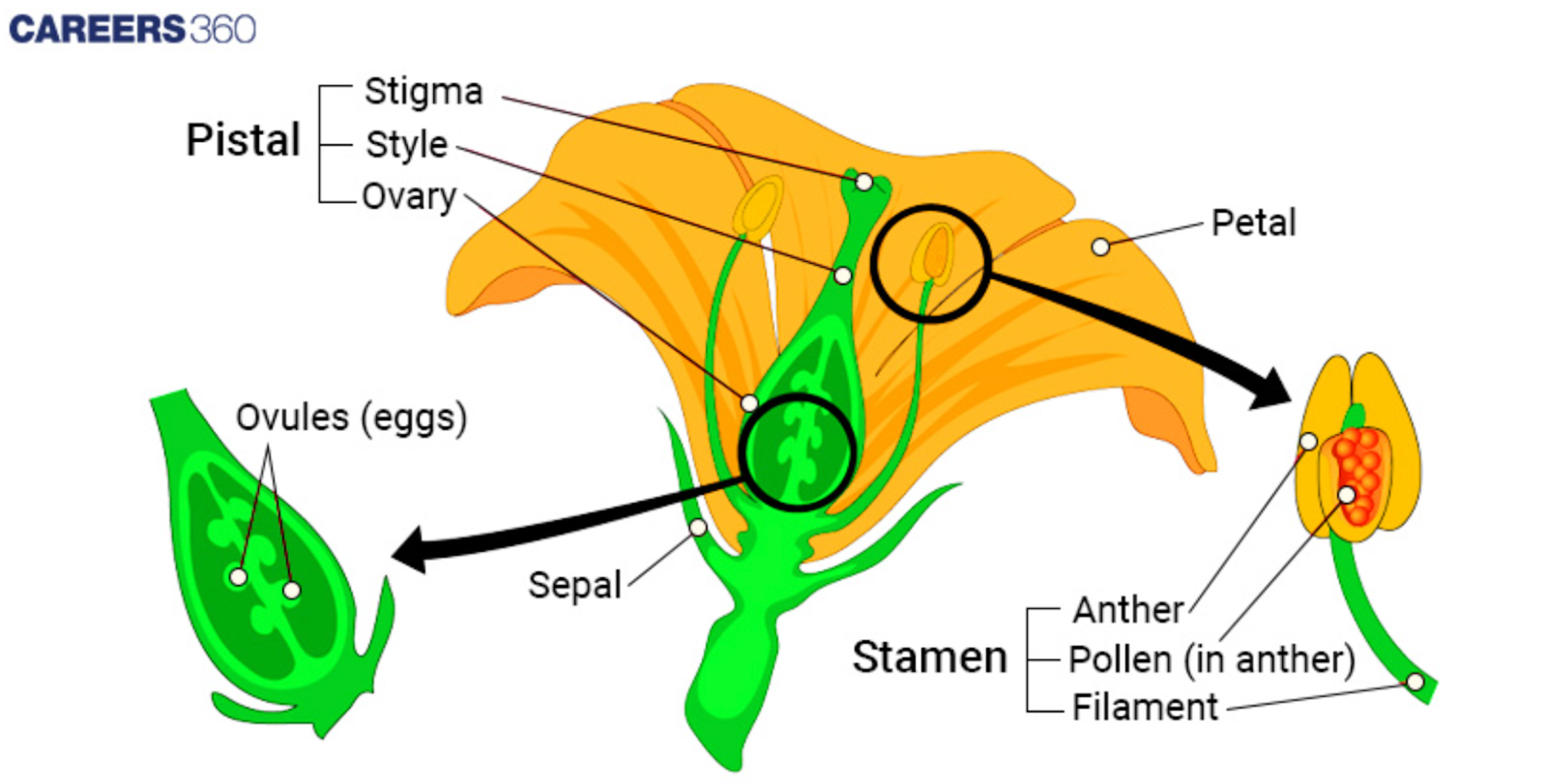Angiosperms - Defination & Characteristics
Angiosperms are plants that produce flowers and seeds enclosed within a fruit. They make up the largest group of plants on Earth, including trees, shrubs, grasses, and many crops. They are important topics in the class 11 chapter on the Plant Kingdom in Biology. In this article, the anatomy and functions of angiosperms are covered, mainly highlighting their reproductive structures, types, and ecological roles.
NEET 2025: Mock Test Series | Syllabus | High Scoring Topics | PYQs
NEET Important PYQ's Subject wise: Physics | Chemistry | Biology
New: Meet Careers360 B.Tech/NEET Experts in your City | Book your Seat now
- What are Angiosperms?
- Characteristics of Angiosperms
- Classification and Diversity of Angiosperms
- Morphological Features of Angiosperms
- Reproductive Biology of Angiosperms
- Physiological Processes of Angiosperms
- Recommended Video on Angiosperm

What are Angiosperms?
A most diverse group of plants on the Earth is the group of angiosperms, which definitely can be distinguished for their ability to produce flowers and encased seeds within fruits. These species are critical in supporting most biomes on the land by offering animals and plants food, shelter, and homes.
Angiosperms are believed to have had their beginnings during the cretaceous period approximately ninety to one hundred and thirty million years ago. They have since diversified to the extent of occupying most of the plant niches on earth because of the adaptive advantages offered by the improvements in this kind of plant. These plants are important in agriculture, horticulture, medicine, and in maintaining ecological systems so, angiosperms are crucial in the current biological sciences.
Also Read:
Characteristics of Angiosperms
The general characteristics of angiosperms that make them distinctive are as below:
Flowering organs - these are the reproductive parts of the plant. The flowers help the plant to reproduce without many crossings with related species. It creates several varieties, leading to the vast diversity of species dominating the land.
Endosperm - the nutritive tissue formed just after fertilisation and zygote formation. It provides necessary food for the growing embryo and the cotyledons till they disintegrate.
Reduced male gametophyte - the pollens are smaller than those in gymnosperms, making fertilisation faster. It gives angiosperms an advantage in evolution.
Stamen - they are lighter and more adapted to cross-pollination. It helps in reducing the possibilities of self-pollination, thereby increasing species diversity.
Carpels enclosing ovules - this helps to prevent self-pollination and fertilisation. The enclosing carpels later turn into fruit, attracting pollinating agents, thereby helping in the dispersion of seeds.
Classification and Diversity of Angiosperms
The classification is described below:
Taxonomic Classification
Kingdom: Plantae
Division: Angiospermae
Class: Monocots and Dicots
Examples of Angiosperms
Angiosperms, or flowering plants, includes numerous families with diverse characteristics and adaptations:
Fabaceae (Leguminosae)
Fabaceae is one of the biggest Legume plant families some of the plants belonging to this family are beans, Phaseolus, peas, Pisum, and soybean, Glycine Max. Well-known for the property of fixing nitrogen and being economically valuable in farming.
Asteraceae (Compositae)
Some of the plants belonging to Asteraceae are sunflower which is scientifically known as Helianthus, daisy known scientifically as Bellis, and aster known scientifically as Aster. In this, the plant has compound inflorescence that has a large number of small flowers closely grouped.
Orchidaceae
Orchids are very diverse and found almost all over the world, they are some 25,000 in number. Characterized by their delicate and frequently ostentatious flowers that are evolved for specific pollination techniques.
Rosaceae
Some of the plants that fall under Rosaceae are roses, commonly known as Rosa, apples which scientifically are classified under Malus, strawberries which scientifically are classified under Fragaria and cherries classified under Prunus. Famous for their pulse and the flowers that are eaten raw or cooked.
Lamiaceae (Labiateae)
Mint plants can also be sorted based on the botanical family which includes mint (Mentha), basil (Ocimum), and sage (Salvia). These are the plants with sweet-smelling leaves and medical uses.
Poaceae (Gramineae)
A large number of important cereal crops are plants of this family such as wheat Triticum, rice Oryza, and maize Zea. Essential in the human diet and for the production of crops.
Morphological Features of Angiosperms
Angiosperms, or flowering plants, includes numerous families with diverse characteristics and adaptations:
Structure of Flowering Plants
The structure of flowering plants includes:
Roots
Flowering plants have different kinds of root systems such as tap root system and bristle root system. They hold the plant in the ground, take water and nutrients from the soil and contain some supply in them.
Stems
Petioles in flowering plants provide Mechanical support to the plant organs like flowers and fruits, help in the conduction of water and nutrients from roots to the aerial parts and food substances from the leaves to other parts of the flowering plant and sometimes have food storage. It has nodes which are areas of connection of leaves and buds and internodes which are a space between nodes.
Leaves
There are various forms and structures of leaves, such as the type, e.g., simple and compound, and the shape of a leaf, for instance, needle-shaped or broad-shaped. They execute photosynthesis, convert light energy to sugars, and release gases into the surroundings.
Flowers
Flowers are the specialized structures for reproduction in plants belonging to the category of angiosperms. Depending on the species, it may have different levels of complexity and may be branched or unbranched with such structures as sepals, petals, stamen (the male organ of reproduction), and pities (the female organ of reproduction). They ensure pollination to enhance the reproduction process, especially through the development of seeds.
Diagram of Parts of an Angiosperm

Reproductive Biology of Angiosperms
Flowering plants exhibit complex reproductive strategies centred around their flower structures:
Flower Structure and Pollination Mechanisms
The mechanism of pollination is described below:
Pollination
Pollination is the process through which pollen grains with male gametophytes are placed on the stigma part of the female reproductive organ, the style while the anther is the male reproductive organ. It can occur through various mechanisms:
Types of Pollination: There are two types of pollination- self-pollination, which is pollination by pollen from the same flower or another from the same plant and cross-pollination which is the transfer of pollen from the flower of one plant to another.
Agents of Pollination: The pollination techniques include anemophily or wind pollination, entomophily or insect pollination, ornithophily or bird pollination, mammalophily or mammal pollination, and hydrophily or water pollination. The colour, fragrance and nectar presentation of flowers also vary to correspond with the following pollinators.
Fertilisation Process
Once pollen comes in contact with a compatible stigma, the pollen tube germinates and grows down the style or the stalk of the pistil and reaches the ovule, the structure within the ovary contains the female gametes. The male gametes reach the female gametes by pollen tube to impregnate the ovule part which is enveloped. This process of fertilisation causes the development of a zygote into an embryo within the seed coat.
Diagram of Flower Structure and Reproductive Process

Physiological Processes of Angiosperms
The physiological process of angiosperms is described:
Photosynthesis
The angiosperms directly capture light in chlorophyll found in chloroplasts to synthesize glucose and oxygen from carbon dioxide and water. Besides, this process facilitates the growth and development of plants and also plays an important role in oxygen generation and the earth’s carbon cycle.
Respiration
The flowering plants use glucose derived from photosynthesis for the production of ATP through aerobic respiration. This process takes place in mitochondria and is pertinent to the overall cellular process of nutrition, growth and division.
Transpiration
Transpiration is the process of loss of water vapour from tissues of plants particularly stomata in the leaves. This process has the effect of developing a pressure deficit at the upper end which drives the upward movement of water and dissolved nutrients from the roots to the shoots. Transpiration is responsible for cooling the plant's level, preserving the internal pressure of plant cells, and transporting minerals to different parts of the plant.
Also Read:
| Reproduction in Plants | Difference between self and cross Pollination |
| Parts of a Seed | Embryogeny in Monocots |
| Seed Formation and Seed Dispersal | Apomixis |
Recommended Video on Angiosperm
Frequently Asked Questions (FAQs)
Angiosperms are defined as flowering plants and refer to seeds enclosed by fruit. The name comes from the Greek words angeion, meaning container or vessel, and sperma, meaning seed.
The presence of flowering organs, endosperms, reduced male and female gametophytes, lighter stamen, and carpels enclosing the ovaries are the specific features that make angiosperms distinct.
Angiosperms first appeared around 130 million years ago, towards the end of the Mesozoic era.
Angiosperms are classified into monocots and dicots based on the number of cotyledons they have.
In desert plants, the leaves are modified to thorn-like structures to reduce water loss. Thick cuticles and sunken stomata are also seen.
These are important in agriculture as food crops – grains – (wheat, rice), fruits and vegetables, and cash crops – (coffee, cotton). They supply industries with basic materials like timber and fibres, and, give out important drugs like aspirin, and morphine among others. Further, they enhance beauty through ornaments like flowers and participate in services like oxygen producers or input to the maintenance of soil structure.
Angiosperms, or flowering plants, are characterized by having flowers and enclosed seeds within a fruit. This is the most diverse group of plants and plays a vital role in ecosystems and agriculture.
Examples of angiosperms include:
Roses (Rosa spp.): Ornamental flowers with beautiful flowers that are fragrant.
Apple Trees(Malus domestic): Fruit-bearing trees that produce apples widely cultivated for food.
Corn (Zea mays): It is a staple crop providing food for humankind and also is an important fodder crop for farm animals.
Differences between Monocots and Dicots: Monocots include one cotyledon, parallel venation of leaves, flowers with parts in sets of three and/or numerous closed companion small vascular documents in the stem. Stomates have two cotyledons, reticulate venation, the flower parts are in fours or fives, and vascular bundles in concentric circles.
Also Read
29 Nov'24 12:43 PM
13 Nov'24 11:17 AM
12 Nov'24 06:32 PM
12 Nov'24 01:31 PM
28 Oct'24 11:50 AM
16 Oct'24 02:07 PM
16 Oct'24 09:55 AM
04 Oct'24 09:33 AM
03 Oct'24 08:28 PM
03 Oct'24 06:50 PM
Articles
Questions related to
Correct Answer: part
Solution : The correct answer is the second option.
Part: This is a reasonable choice, as it refers to a portion or component. In the context of geographical areas, it might be more commonly associated with a segment or division of a larger whole, like a part of a desert region.
The meanings of the other options are as follows:
Slot: This word typically refers to a narrow opening or groove. It doesn't quite fit the context of being a part of ancient desert vegetation.
Task: This word refers to a specific job or assignment. It doesn't convey the idea of being a component of ancient desert vegetation.
Bit: This word is often used to denote a small piece or part.
Therefore, part is the most appropriate option for filling in the blank in the given context.
Correct Answer: The transport of male gametes in bryophytes and pteridophytes occurs through water.
Solution : The correct answer is The transport of male gametes in bryophytes and pteridophytes occurs through water.
The transport of male gametes in bryophytes and pteridophytes occurs through water. The male gametes of bryophytes and pteridophytes are motile and can swim through water with the help of their flagella. They are transferred to the female reproductive organ for fertilisation.
Correct Answer: example
Solution : The correct choice is the second option.
Example: This word denotes a representative instance that illustrates a general pattern. It is a reasonable choice, and it can be suitable in certain contexts.
The meanings of the other options are as follows:
Signal: This word typically refers to a gesture or action that conveys information.
Instance: This word means a particular occurrence or case.
Sign: It can be used to indicate something.
Therefore, the correct word to fill in the given blank is an example.
Correct Answer: rain
Solution : The correct answer is the second option.
The phrase suggests that mountain ranges provide shelter from something. The most fitting option is rain, as mountains can create rain shadows, blocking the passage of rain clouds and resulting in dry conditions on the leeward side (the side facing away from the prevailing wind).
The meanings of the other options are as follows:
Brash: This word refers to fragments of ice on the surface of water and is not relevant to the context of mountain ranges and deserts.
Birds are not typically associated with providing shelter to deserts in this context.
Animals: While animals might seek shelter, the sentence specifically discusses the role of mountain ranges in providing shelter to deserts, making "animals" less relevant.
Therefore, the correct answer is rain.
Correct Answer: characterised
Solution : The correct choice is the third option.
In the context of the passage, the sentence discusses the characteristics or features of the ancient desert vegetation. It means to describe the distinctive qualities or features of something "characterised" as the best fit.
The meanings of the other options are as follows:
Mandated: This word means required or officially ordered. It doesn't fit the context of describing the features or nature of ancient desert vegetation.
Summarised: This word means to present a concise version of something. It doesn't convey the idea of describing the characteristics in detail.
Presented: This word describes showing or offering something.
Therefore, characterised is the most appropriate option for filling in the blank in the given context.